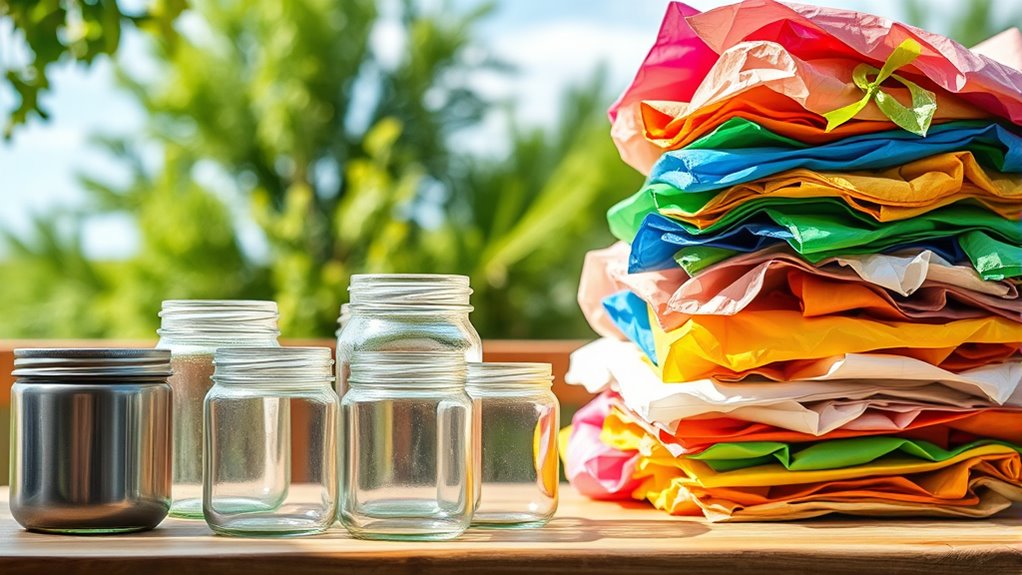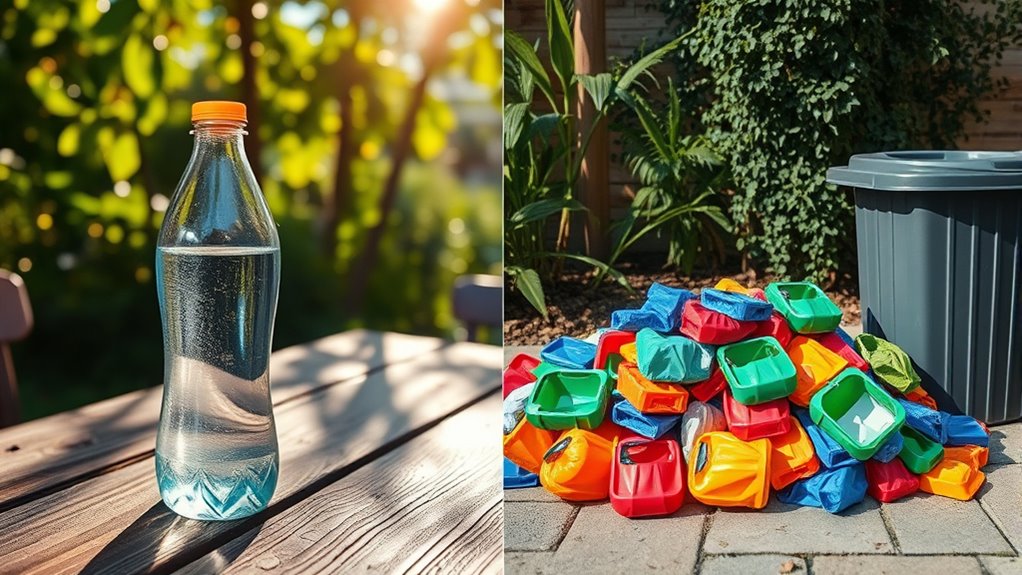Choosing between reusable and recyclable items depends on your goals. Reusables have a higher initial environmental impact but pay off over time through repeated use, reducing waste and demand for single-use plastics. Recyclables can be processed into new products, but they often require energy and are less effective if contaminated. To truly help the earth, understanding how combining reusing, recycling, and biodegradable options makes the biggest difference is key—exploring further reveals even more ways to minimize your impact.
Key Takeaways
- Reusables generally have a higher initial environmental impact but offer long-term benefits through repeated use.
- Recyclables can be processed into new products but often require energy and may degrade over time.
- Reusables reduce demand for single-use plastics, decreasing waste and pollution over time.
- Recycling helps manage waste but is less effective due to contamination and downcycling issues.
- Combining reusing and recycling strategies maximizes overall environmental sustainability.

Have you ever wondered whether choosing reusable items or recyclable materials makes a bigger difference for the environment? It’s a common question with no one-size-fits-all answer, but understanding the impact of your choices can help you make smarter decisions. When it comes to reducing waste, many people focus on avoiding single-use plastics, which often end up in landfills or polluting oceans. Reusable items, like water bottles, shopping bags, and containers, are designed to be used multiple times, cutting down on the need for continuous production and disposal of single-use plastics. On the other hand, recyclable materials, such as certain plastics, metals, and paper, can be processed and turned into new products. But recycling isn’t always the perfect solution because it consumes energy and sometimes results in downcycling—where materials degrade in quality after processing.
Biodegradable packaging adds another layer to the conversation. Made from natural materials like cornstarch or plant fibers, biodegradable packaging is designed to break down more quickly in the environment compared to traditional plastics. This is especially important for items that are difficult to reuse, like takeout containers or packaging peanuts. Switching to biodegradable packaging can substantially lessen the burden of waste, but it doesn’t eliminate the need to manage waste properly. If biodegradable materials end up in landfills, they may not decompose as intended due to the lack of oxygen and suitable conditions, which means they can still contribute to environmental issues.
Choosing reusable over recyclable isn’t always straightforward. Reusables tend to have a higher upfront environmental cost because of manufacturing and transportation, but they pay off over time with repeated use. Conversely, recyclable products might seem environmentally friendly because they can be processed into new items, but the process itself consumes energy and resources. Plus, contamination and improper disposal often prevent recyclable materials from being processed correctly, making the recycling process less effective. Additionally, advancements in projector technology demonstrate how innovations can reduce resource consumption in various industries.
Ultimately, the most earth-friendly choice depends on your habits and the context. Using reusable items whenever possible minimizes waste and reduces demand for single-use plastics. Incorporating biodegradable packaging for items you can’t reuse helps break down waste more naturally. Combining these approaches—reducing, reusing, and recycling—maximizes your positive impact on the environment. The key is to be conscious of how you dispose of your waste and to support products and packaging that align with sustainable practices. By doing so, you help reduce pollution, conserve resources, and contribute to a healthier planet.
Frequently Asked Questions
How Many Times Can a Reusable Item Be Used Before It Becomes Waste?
You wonder how many times you can use a reusable item before it becomes waste. It depends on its durability thresholds and your usage frequency. Usually, you can use a reusable product dozens to hundreds of times if you follow care instructions. Regularly check for signs of wear or damage, and replace it when necessary. By doing so, you maximize its lifespan and reduce overall waste, making it more eco-friendly.
Are Recyclable Products Always Environmentally Better Than Non-Recyclable Ones?
Imagine thinking recyclable products are always the earth’s heroes—think again! Recyclable items aren’t automatically better than non-recyclables, especially when considering single-use plastics that can’t be recycled or biodegradable packaging that breaks down naturally. Sometimes, choosing reusable options or reducing consumption altogether has a bigger environmental impact. So, don’t assume recyclability equals eco-friendliness; weigh the full lifecycle and your habits for true sustainability.
What Environmental Impacts Are Associated With Recycling Processes?
When you think about recycling processes, consider the environmental impacts involved. Recycling often requires significant energy consumption, which can lead to higher carbon emissions. A thorough life cycle assessment shows that some materials may have a bigger environmental footprint during recycling than producing new ones. While recycling helps reduce waste, you should weigh these impacts against the benefits to make more eco-friendly choices.
Can Some Materials Be Both Reusable and Recyclable?
Imagine dual material products that serve multiple purposes, reducing waste. Yes, some materials are both reusable and recyclable, like glass bottles or certain plastics, making them versatile choices. Biodegradable options also fit this category, breaking down naturally while being reused or recycled. By choosing these, you support sustainability, minimizing environmental impact. You can confidently select items that are both reusable and recyclable, helping protect the planet with every use and disposal.
How Does Transportation Affect the Eco-Friendliness of Reusable and Recyclable Items?
Transportation impacts the eco-friendliness of reusable and recyclable items by influencing their overall carbon footprint. When you choose items that require less transportation or are produced locally, you reduce transportation emissions. Reusable products often travel less, especially if used repeatedly, lowering emissions. Recyclable items may need transportation for processing, which adds to emissions. Being mindful of sourcing and transportation distances helps you make more eco-friendly choices, minimizing your overall environmental impact.
Conclusion
Choosing between reusable and recyclable items is like tending a garden—you nurture what grows best, knowing each choice shapes your environment. Reusables act as sturdy trees, standing tall season after season, while recyclables are like seeds that can be reborn into new life. By making mindful decisions, you’re planting the roots for a healthier Earth. Remember, your everyday choices are the water and sunlight nurturing this garden—so pick wisely and watch your impact blossom.









